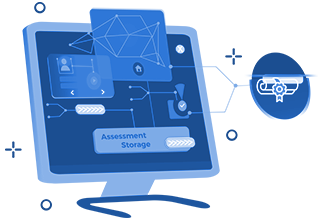In Canada, as in many countries throughout the world, postsecondary education is constantly evolving. Educational systems across the country change as governments and education authorities identify new priorities and develop strategies to respond to the needs of a rapidly changing world. This report presents an overview of postsecondary education systems in Canada — their historical background, how they are structured, and how they function. It is important to note that in Canada, postsecondary education encompasses all types of formal instructional programs beyond secondary school, including academic, vocational, technical, and continuing professional education offered primarily by universities, colleges, and institutes.
A more detailed look at individual provincial and territorial systems is available at Postsecondary Education Systems in Canada, Provinces and Territories.
About Canada
Government
Canada is a federation of ten provinces and three territories. Under the Canadian constitution, provincial governments have exclusive responsibility of all levels of education. There is no ministry or department of education at the federal level. Canada's three territories, Yukon, Northwest Territories, and Nunavut, do not have the same constitutional status as the provinces, and are subject, in many areas, to more direct control from the federal government. With respect to education, however, the federal government has delegated this responsibility to the territorial governments, which, in turn, cooperate with the provinces to deliver postsecondary programs.
Culture
Canada is highly diverse culturally, with more than 200 ethnic origins and 200 first languages reported in the 2006 census. There are two major linguistic groups and two official languages, English and French. In 2006, over 57 per cent of the population reported English as their first language and almost 22 per cent reported French as their first language. The vast majority of francophones in Canada live in Quebec, where 79 per cent have French as their mother tongue. Almost 4 per cent of the Canadian population self-identified as Aboriginal.
Geography
Canada is the second largest country in the world. Because of its climate, there are no permanent settlements in nearly 90 per cent of the country. Most of Canada's more than 33 million people live in highly urbanized centres in the south, within 300 kilometres of the border with the United States.
Economy
Canada is a major industrialized trading nation, a member of the G7/8, the G20, the Organisation for Economic Co-operation and Development, and many other international bodies. The critical connection between a highly educated workforce and Canada's continuing prosperity is at the core of Canadian economic policy.
Education
Canada has one of the highest rates of postsecondary-education completion in the world. According to the 2006 census, six out of every 10 adults between 25 and 64 years of age had completed some form of postsecondary education.
An Historical Overview
Postsecondary education in Canada dates from 1663, with the establishment of the Grand Séminaire de Québec, a forerunner of Laval University. At the time of Confederation in 1867, there were 18 universities and a number of classical colleges in Canada.
At the end of World War II, a federally funded veterans' rehabilitation program brought an influx of veterans to university campuses. New institutions were established and universities continued to expand throughout the 1950s, '60s, and '70s.
While some public colleges date back to the 1920s, most were established in the 1960s. These institutions were created by provincial governments in response to a need for vocational and technical training, to complement the education offered at universities. Open access was a key objective for the new institutions. Perhaps the most sweeping changes were made in Quebec, where the province reconstituted some 200 classical colleges, instituts familiaux, and several technical institutes into a single system.
The 1990s again saw significant changes in Canada's postsecondary education systems. Some public colleges and institutes were given degree-granting authority by their provincial governments, and mechanisms were established to expand college–university credit transfer. A small number of private postsecondary institutions also obtained permission to offer degree programs. Information technology became readily available and increasingly blended with more traditional delivery systems. Recruitment efforts to attract international students increased substantively after 2000.
 English
English Français
Français 日本語
日本語 中文
中文 한국어
한국어 Русский
Русский










